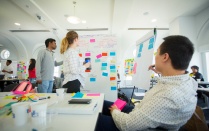Including People with Disabilities in the "Sanitation-for-All" Agenda

Before adaptation, Hugues Nouvellet Handicap International, 2011, Modified
By Gauri Desai
Published December 10, 2015 This content is archived.
The United Nations General Assembly has reaffirmed that clean drinking water and sanitation are vital to human health and has explicitly stated that access to water and sanitation is a fundamental human right [1]. From this principle, the UN sought to double the proportion of people around the world with sustainable access to basic sanitation from 2000 to 2015. The target was missed by almost 700 million people [2].
The greatest challenge was in meeting the needs of the most vulnerable populations, such as women and adolescent girls, older adults, and residents of rural communities and informal settlements. People with disabilities, in particular, have largely been ignored in water, sanitation, and hygiene (WaSH) programs. Some people with disabilities are forced to practice open defecation despite the presence of improved sanitation facilities, which hygienically separate human excreta from human contact. Many existing facilities are not accessible, i.e., they are not designed with the needs of people with disabilities in mind.
People with disabilities face physical, attitudinal, and institutional barriers to a host of services – education, health care, employment, and recreation – including sanitation.
Physical barriers are based on the natural and built environment of facilities. Long distances to sanitation facilities, muddy roads, and steep slopes are obstacles to reaching facilities [3]. High steps, narrow entrances, slippery floors, the height of plumbing fixtures, limited space inside facilities, and a lack of handles for support present both functional and sanitary problems [3]. A person with paralysis of the lower limbs who uses a squat toilet, for example, is forced to touch the floor of the toilet for support and for maintaining posture in the absence of supporting handles inside the facilities.
People with disabilities also face attitudinal barriers, such as stigma, prejudice, pity, and misinformation, which vary by country and culture [4,5]. In certain Asian countries, for instance, the practice of cleaning oneself with the left hand after toileting is prevalent. People with disabilities who cannot use the left hand may lead to stigmatization [6]. Likewise, in Madagascar, disability is viewed as a punishment from God for a past sin. A person with disability is regarded useless and is denied the opportunity to express needs [3]. Attitudinal barriers are often the most difficult to identify and hard to overcome, and in turn, can contribute to inadequate design.
Institutional barriers include policies, funding streams, and practices that (intentionally or unintentionally) discriminate against people with disabilities. Attitudinal barriers often underpin institutional barriers. Catarina de Albuquerque, special rapporteur on the human rights to safe drinking water and sanitation, in her keynote address on the post-2015 WaSH indicators, cited five elements of inclusive water and sanitation: availability, quality, acceptability, affordability, and accessibility. She noted, however, that people with disabilities are most often deprived of adequate sanitation because these criteria go unmet.
Given the hundreds of millions of people with disabilities worldwide, the result is discrimination against a large section of society. To achieve the UN Sustainable Development Goal of sanitation for all by 2030, WASH programs must take on the environmental, attitudinal, and institutional barriers that continue to marginalize people with disabilities and, in turn, place all citizens at risk.
References
- Assembly, U.N.G., Resolution 64/292 The human right to water and sanitation. 2010.
- WHO/UNICEF, Progress on Sanitation and Drinking Water - 2015 Update and MDG Assessment. 2015. p. 90.
- Jones, H., J. Fisher, and R. Reed, Water and sanitation for all in low-income countries. 2012.
- Gosling, L., Equity and inclusion: A rights-based approach. London: WaterAid, 2010.
- Snider, H. and N. Takeda, Design for all: implications for bank operations. World Bank, Washington, 2008.
- Van der Kroft, M., Response to research questionnaire. Overseas Disability Adviser, Save the Children/UK, 2002.
